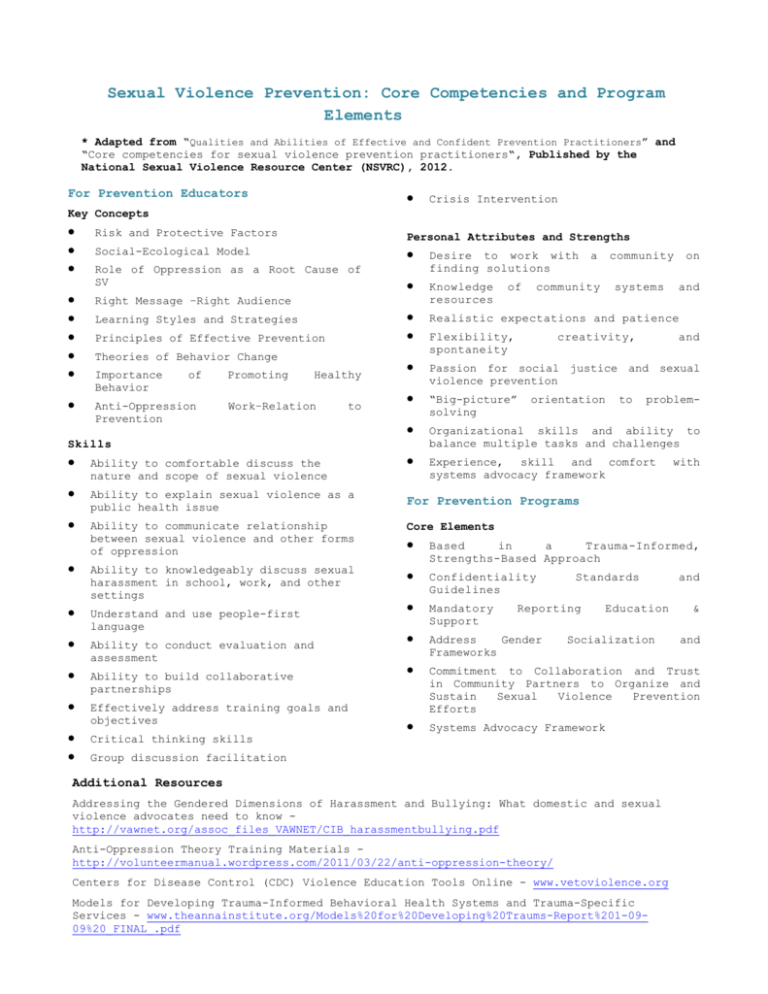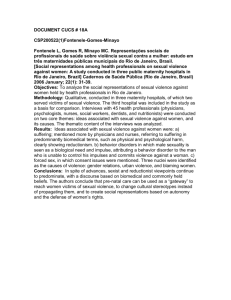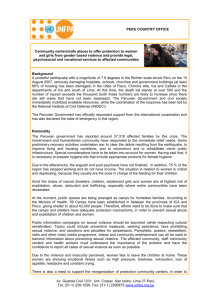Sexual Violence Prevention: Core Competencies and
advertisement

Sexual Violence Prevention: Core Competencies and Program Elements * Adapted from “Qualities and Abilities of Effective and Confident Prevention Practitioners” and “Core competencies for sexual violence prevention practitioners“, Published by the National Sexual Violence Resource Center (NSVRC), 2012. For Prevention Educators Crisis Intervention Key Concepts Risk and Protective Factors Personal Attributes and Strengths Social-Ecological Model Role of Oppression as a Root Cause of SV Right Message –Right Audience Learning Styles and Strategies Principles of Effective Prevention Theories of Behavior Change Importance Behavior of Anti-Oppression Prevention Promoting Healthy Work–Relation to Skills Ability to comfortable discuss the nature and scope of sexual violence Desire to work with finding solutions Knowledge resources of Flexibility, spontaneity creativity, “Big-picture” solving orientation Ability to build collaborative partnerships Effectively address training goals and objectives Critical thinking skills to problem- Experience, skill and comfort systems advocacy framework Ability to knowledgeably discuss sexual harassment in school, work, and other settings and Organizational skills and ability to balance multiple tasks and challenges Core Elements Ability to conduct evaluation and assessment and Passion for social justice and sexual violence prevention Ability to communicate relationship between sexual violence and other forms of oppression systems on Realistic expectations and patience For Prevention Programs Understand and use people-first language community community Ability to explain sexual violence as a public health issue a with Based in a Trauma-Informed, Strengths-Based Approach Confidentiality Guidelines Mandatory Support Standards Reporting Address Gender Frameworks Education Socialization and & and Commitment to Collaboration and Trust in Community Partners to Organize and Sustain Sexual Violence Prevention Efforts Systems Advocacy Framework Group discussion facilitation Additional Resources Addressing the Gendered Dimensions of Harassment and Bullying: What domestic and sexual violence advocates need to know http://vawnet.org/assoc_files_VAWNET/CIB_harassmentbullying.pdf Anti-Oppression Theory Training Materials http://volunteermanual.wordpress.com/2011/03/22/anti-oppression-theory/ Centers for Disease Control (CDC) Violence Education Tools Online - www.vetoviolence.org Models for Developing Trauma-Informed Behavioral Health Systems and Trauma-Specific Services - www.theannainstitute.org/Models%20for%20Developing%20Traums-Report%201-0909%20_FINAL_.pdf Overview of the Social Ecological Model - www.cdc.gov/violenceprevention/overview/socialecologicalmodel.html Pennsylvania Coalition Against Rape Sexual Harassment Prevention Curriculum Grades K-12 www.pcar.org/sites/default/files/file/TA/Sexual-Harassment-Prevention-in-SchoolsCurriculum-Manual.pdf People First Language Article and Chart - www.disabilityisnatural.com/images/PDF/pfl09.pdf www.disabilityisnatural.com/images/PDF/pflchart09.pdf The Parallels of Racism and a Rape Culture www.wcsap.org/sites/www.wcsap.org/files/uploads/documents/RacismandARapceCulture2007r1.pdf For more information call UCASA or visit our website at www.ucasa.org Telephone: 801.746.0404 Toll-free: 866.87.UCASA Email: info@ucasa.org Statewide 24-Hour Crisis Line: 888.421.1100











